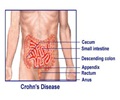Study says surveillance colonoscopy is effective and cost-effective when targeted to high-risk patients
Anew study in Gastroenterology, the official journal of the American Gastroenterological Association (AGA) Institute says that surveillance colonoscopy is effective and cost-effective when targeted to high-risk patients. However, overuse of surveillance colonoscopy could be excessively costly or even harmful.
"Surveillance colonoscopy is a widely accepted and utilized practice that has the potential to decrease the burden of colorectal cancer. Yet, this practice also carries considerable monetary and resource costs as well as the risk of procedure-related complications," said Sameer Dev Saini, MD, MS, of the Ann Arbor VA Health Services Research & Development Center of Excellence and lead author of the study. "Despite these concerns, data supporting the long-term effectiveness of surveillance colonoscopy and the choice of optimal surveillance strategy are limited."Current guidelines recommend that patients with colonic adenomas undergo periodic surveillance colonoscopy. Surveillance colonoscopies are performed to examine the colon after a colorectal abnormality, either cancerous or benign, has been detected and removed. But, is doing so cost effective? Dr. Saini and colleagues sought to answer this question by using existing data to make projections about the effectiveness and cost utility of surveillance. They developed a Markov model based on published literature to study various surveillance strategies from the perspective of a long-term payor (the target population was 50-year-old patients with newly diagnosed colonic adenomas followed until death).
According to study results, colonoscopy every three years in high-risk patients and every 10 years in low-risk patients (3/10 strategy) was more costly, but also more effective than no surveillance (incremental cost-effectiveness ratio [ICER] of $5,743 per quality-adjusted life year [QALY] gained). A cost-utility analysis suggested that the 3/10 strategy is the optimal strategy under the vast majority of clinical circumstances.
A 3/5 strategy (colonoscopy every three years in high-risk patients and every five years in low-risk patients) was considerably more costly, but only marginally more effective (ICER of $296,266 per QALY). This strategy may be reasonable in populations in which a low-risk subgroup cannot be reliably identified or if the miss rate for advanced adenomas is believed to be very high (at least 14 percent). Compared to the 3/10 strategy, the 3/5 strategy resulted in five fewer cancers and one fewer cancer-related death per 1,000 patients entering surveillance.
A 3/3 strategy (colonoscopy every three years in both high- and low-risk patients), which may be attractive to gastroenterologists with medico-legal concerns over missed neoplasia, is cost-ineffective and potentially harmful in comparison to less intensive surveillance. Compared to the 3/5 strategy, the 3/3 strategy resulted in two fewer cancers and one fewer cancer-related death per 1,000 patients entering surveillance.
In the future, improvements in risk stratification could further enhance physicians' ability to target surveillance to those patients most likely to benefit from this practice.
Advertisement
Source-Eurekalert










